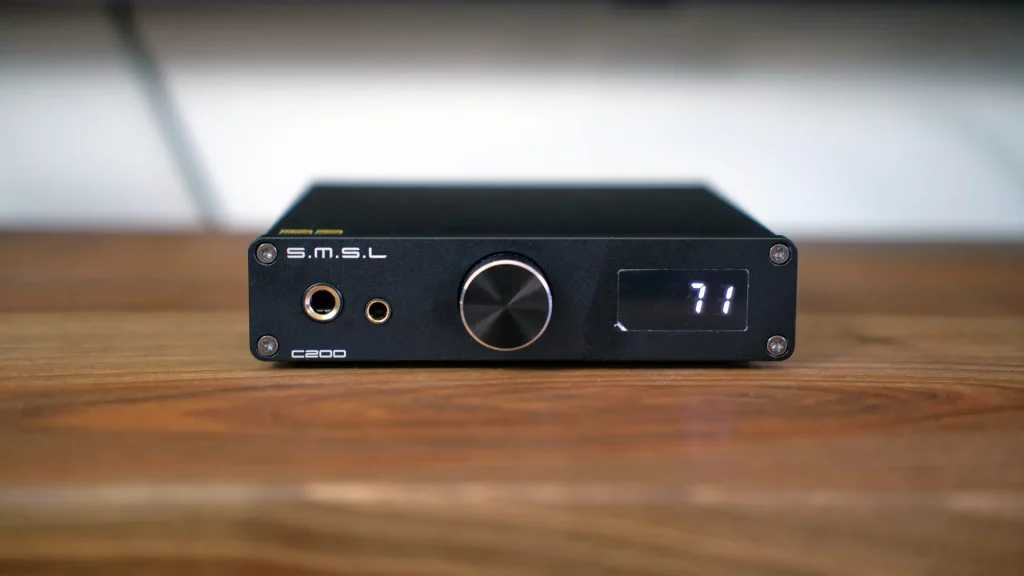Coming at around two hundred dollars, SMSL C200 doesn’t bring anything new and exciting to the table. What it does offer is a good balance of features, sonic qualities, and value. So let’s take a closer look.
Build and Features
SMSL C200 has a straightforward design. Looking at its front, it’s a slim black slab with a centered volume knob that doubles as a button, a small LCD, and two headphone outputs: 4.4 mm and 6.35 mm. In the back, we can find a pair of RCAs as well as TRS outs. The thing to note here is that neither output is balanced, so 4.4 mm and TRS are just here for “convenience”. When it comes to inputs, we have the usuals: USB which comes in form of USB-C, Optical Toslink, and Coaxial SPDIF. Bluetooth 5.0 with LDAC support is also onboard. That would be it, pretty decent connectivity at this price point I would say. If you care about the long list of tech specs, feel free to look at the specification table at the end of the review.
As for the build quality itself, there’s nothing to complain about. The whole case is made of sturdy aluminum, as we came to expect these days. The only thing that’s not metal is a small plastic remote, which is also quite common at this price point.


Sound
I won’t be dividing sound impression into dedicated headphone out and line-out because SMSL C200 exhibits the exact same sonic qualities across the board. A headphone amplifier has plenty of power to drive almost anything you can throw at it, so that will never be a limiting factor. So whatever you read here goes for all of its outs. Having that in mind, let’s start.
If you’re at all familiar with the house sound of SMSL’s newer DAC offerings, the slightly warmer sonic signature of C200 will not surprise you. This warmth is most noticeable in the bass and midbass sections that lend nice fullness to the overall sound signature without influencing or muddying the midrange. Midrange itself is nicely resolving and natural sounding, without excessive sharpening or being obsessed with outlining the edges of a tone with laser-like precision. The same can be said about the highest part of the frequency response which feels open and revealing, but not too prominent or overly bright. All of this put together makes for a natural blend with a slight hit of warmth that doesn’t deviate much from something that most of us would call neutral.
Now moving away from the tonality, you can notice that C200 offers a nicely developed soundstage that is one of the best in class. Inside it, instruments and vocals are arranged with precision and a decent amount of breathing space. It definitely doesn’t sound flat or congested, and that’s a welcomed trait that is not guaranteed in this market segment.
Lastly, talking about dynamics, that’s quite decent too. SMSL C200 is not the quickest-sounding DAC, but it’s definitely not a slouch either. It goes through fast-paced rhythms without losing a foot and with a decent dynamic scale. Some Topping rivals may sound more nimble when it comes to the time domain response, but they will lack some other traits that C200 has. And while on that topic, it’s time for some comparisons.
Comparison
Topping DX3 Pro Plus is probably the most direct competitor on the market. Their build quality is equally good but Topping lacks 4.4 mm and TRS outputs that C200 has. Talking about their sonic qualities, they’re quite different too. DX3 pro+ is prioritizing fast and analytical sound above all else. It has plenty of resolution, even bass punch, but the midrange is on the thin and dry side leaving bright highs to dominate the picture. SMSL C200 is warmer and softer sounding, one might say less resolving if we were to focus only on crisp tone edges. But the tone timbre itself is definitely better with C200 which sounds noticeably fuller and more natural to my ears. With greater drive, dynamics, and bass control, DX3 Pro+ might be more rewarding for electronic music. If you’re more about acoustic recordings, however, C200 should win your heart with a fuller tonality and richer tone timbre. I know I preferred it for my own music taste.
Conclusion
SMSL C200 is a well-balanced design that offers very decent sound quality. It doesn’t excel in any particular way, but it does most things just right and has no serious shortcomings. I don’t know about you, but striking a good balance and offering the kind of sound that can be enjoyed for long periods of time is high on my list of priorities. All that said, I find C200 to be one of my favorite DAC/AMPs around two hundred dollars.
| SMSL C200 – CHARACTERISTICS |
|
Input: USB / Optical / Coaxial / Bluetooth. |





